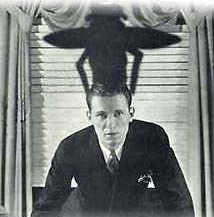
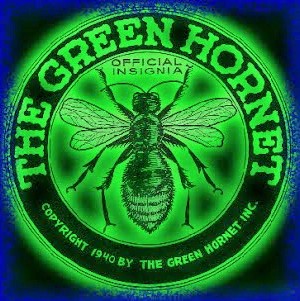 The Green Hornet (1936-1952) aired “Trouble Hits the Trolley” on February 27, 1936 as its 7th episode out of over 1,000. The Green Hornet was created specifically for radio by producer George Trendle and director James Jewell. The first episode aired January 31, 1936. The series proved so popular its run lasted sixteen years, with its final episode airing in late 1952. The 1940s saw two movie serials featuring the Green Hornet and his staunch ally Kato (The Green Hornet–1940, and The Green Hornet Strikes Again!–1941), which only served to heighten the popularity of the radio show. Several attempts at Green Hornet movies have been made (most recently in 2011) but none have proved as successful as the radio show (this includes the short-lived Green Hornet TV show from the 1970s, which nevertheless catapulted Bruce Lee to stardom in his role as Kato). Over its long radio run four actors were the voice of Britt Reid/the Green Hornet. From the show’s inception in 1936 through January 1943 Al Hodge (1912-1979) was the voice of the Hornet (photo upper right). In later years he would take on the role of Captain Video (1950-55, photo lower right) for the early television show Captain Video and His Video Rangers (1949-55), the first show of its kind on American television.
The Green Hornet (1936-1952) aired “Trouble Hits the Trolley” on February 27, 1936 as its 7th episode out of over 1,000. The Green Hornet was created specifically for radio by producer George Trendle and director James Jewell. The first episode aired January 31, 1936. The series proved so popular its run lasted sixteen years, with its final episode airing in late 1952. The 1940s saw two movie serials featuring the Green Hornet and his staunch ally Kato (The Green Hornet–1940, and The Green Hornet Strikes Again!–1941), which only served to heighten the popularity of the radio show. Several attempts at Green Hornet movies have been made (most recently in 2011) but none have proved as successful as the radio show (this includes the short-lived Green Hornet TV show from the 1970s, which nevertheless catapulted Bruce Lee to stardom in his role as Kato). Over its long radio run four actors were the voice of Britt Reid/the Green Hornet. From the show’s inception in 1936 through January 1943 Al Hodge (1912-1979) was the voice of the Hornet (photo upper right). In later years he would take on the role of Captain Video (1950-55, photo lower right) for the early television show Captain Video and His Video Rangers (1949-55), the first show of its kind on American television.
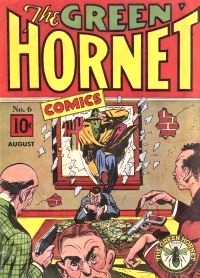
The Green Hornet’s real identity is Britt Reid, publisher of the Daily Sentinel. During a visit to the Far East, Reid saved Kato’s life. Kato now links his fortune to that of Reid as a faithful companion, driver of the Black Beauty (forerunner of the Batmobile), and all-around aide-de-camp. (Cover at left from The Green Hornet #6, August 1940.)
In the 1930s America was rife with criminal organizations, and not only they, but the common criminal element led to many a radio show featuring crime fighters of various stripes. Of those shows featuring crime busters with secret identities, or a special ability or power, or who employed scientific or advanced technology to thwart criminals, perhaps the most popular trio was Dick Tracy (1934-48), The Green Hornet (1936-52), and The Shadow (1937-54). To place the popularity of these “special” crime fighter shows (as opposed to straight detective or police programs, of which there were many) in some sort of perspective, the Great Depression lasted from 1929-39. During this difficult time the underworld took advantage of a ruined economy in any way it could, including bootlegging illegal alcohol during the era of Prohibition (1920-33). While this was but one enterprise crime families adopted, their schemes and violence were felt in many areas of public life. Al Capone was probably the most well known crime family boss of the time, but by the time The Green Hornet program hit the airwaves Capone was himself out of the picture, having been sent to a Florida prison in 1931, where he would die eleven years later. But crime and crime families continued without Al Capone. Scams, cons, local crime gangs, and any number of rackets bent on cheating the public or enriching one’s own pockets abounded (as they do today).
“Trouble Hits the Trolley” is the story of a crooked businessman who forcefully uses the power of the press to sway public opinion. He has invested heavily in a new line of buses which he desperately needs to succed in replacing the city’s trolleys. All of a sudden, it would seem, there have been a series of trolley “accidents,” and though Britt Reid’s newspaper, The Daily Sentinel, has provided timely, accurate coverage of the incidents, he discovers quite by accident that a rival paper has been beating the Sentinel to the punch, and with a spin to its stories that have placed in the public’s mind a negative view of their trolleys. Thus does Reid assume his secret identity of the Green Hornet to get to the bottom of it all. Of course, he uncovers coercion and collusion between the rival newspaper and the morally bankrupt businessman, the deadly lengths to which he is willing to go, and all for personal gain. An old story that is unfortunately still with us and probably always will be, but at least on radio and more than 80 years ago we had the Green Hornet as a champion. So listen now to “Trouble Hits the Trolley” and remember that there is little new in the way the criminal mind works or the schemes arising from within it, for these schemes always seem to recycle themselves, and what might seem new to younger folks or newer generations is probably very old, and more often than not stem from weakness of character and simple greed.
[Note: The extended Green Hornet theme at the beginning and middle of this episode acts as a placeholder so local affiliates can drop in local advertising.]
Play Time: 27:31
{The Great Depression (1929-39) couldn’t deter our intrepid neighborhood gang from scrimping and saving their nickels and dimes for that wonderful, joyous trip to the neighborhood newsstand in search of their favorite SF pulp magazines. Astounding (1930-present, now Analog) was always grabbed on sight as one of their choices. This issue proved to be somewhat of a classic (along with the next two), for it ran the first part of H. P. Lovecraft’s novella “At the Mountains of Madness.” Originally rejected by Weird Tales editor Farnsworth Wright because of its length, it found an unlikely home at Astounding five years later. Astounding was a monthly in 1936 as it had been since its inception. Wonder Stories (1930-36), like several other adventure-oriented SF pulps, went for garish (but exciting) covers to match its wildly imaginative content. It was a monthly until its last three issues, which were bi-monthly. The issue below was the magazine’s next to last. Weird Tales (1923-54) had been a long time favorite and was almost as guaranteed a purchase every month as was Astounding. Many of its stories have become classics in the fantasy, dark fantasy, horror, and supernatural fields and have been oft-reprinted. It, too, was a monthly in 1936.}
[Left: Astounding, Feb. 1936 – Center: Wonder Stories, Jan/Feb 1936 – Right: Weird Tales, Feb. 1936]
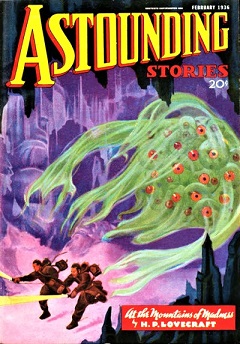
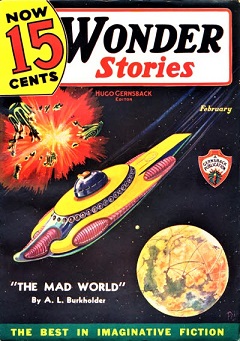
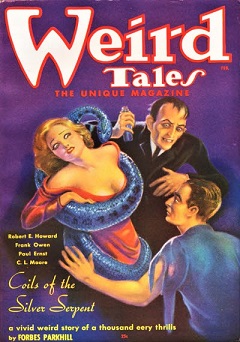
To view the entire list of weekly Old Time Radio episodes at Tangent Online, click here.